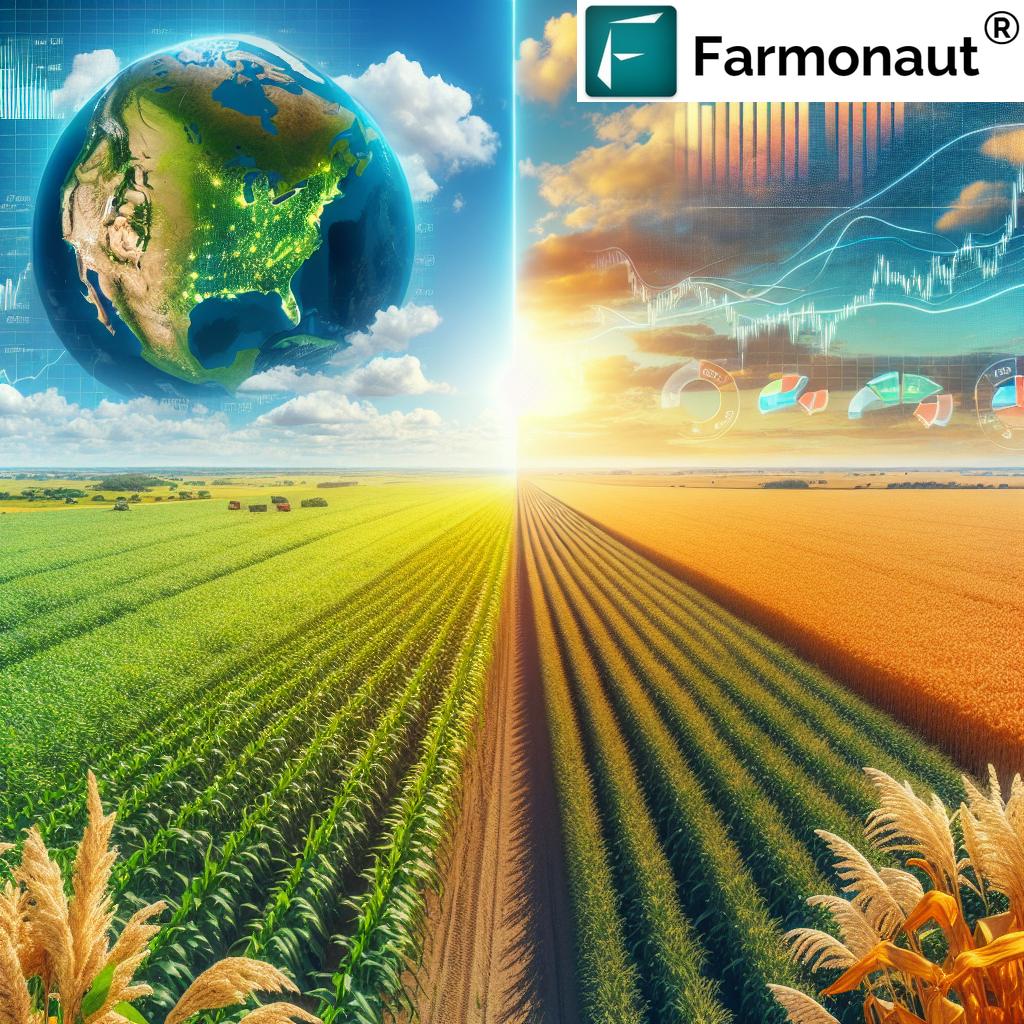Corn and Soybean Futures Surge: How Weather and Trade Impact Global Crop Supply
“Corn and soybean futures on the Chicago Board of Trade have reached multi-month highs, impacting global crop supply forecasts.”
In the ever-evolving world of agricultural futures trading, we’re witnessing significant shifts that are reshaping the global crop supply outlook. As experts in the field, we at Farmonaut are closely monitoring these trends and their implications for farmers worldwide. Today, we’ll delve into the recent surge in corn and soybean prices, exploring how weather patterns and trade dynamics are influencing the market.
The Current State of Corn and Soybean Futures
On February 6, 2023, the Chicago Board of Trade (CBOT) saw a notable upward momentum in agricultural futures. Corn and soybean prices approached multi-month highs, driven by a complex interplay of factors. Let’s break down the numbers:
- Corn: The most actively traded contract reached $4.94-1/4 per bushel, showing a 0.2% increase.
- Soybeans: Prices climbed to $10.63-3/4 per bushel, up by 0.6%.
- Wheat: Remained stable at $5.72-1/4 per bushel.
These figures represent significant milestones:
- Corn hit a 16-month peak at $4.98-1/2
- Soybeans touched a 6-1/2-month high at $10.79-3/4
- Wheat reached a 3-1/2-month high at $5.84-1/4
As we analyze these trends, it’s crucial to understand the underlying factors driving these price rallies.
Weather Impact on Crop Yields
Weather conditions play a pivotal role in shaping crop yields and, consequently, market prices. Recent weather patterns have had a significant impact on global crop production, particularly in key regions like Argentina and the Black Sea area.
Argentina’s Soybean Production
Argentina, the world’s leading exporter of soy oil and meal, and the third-largest exporter of corn, has been grappling with dry conditions. However, recent developments have brought some relief:
- Rainfall on February 5 and 6 provided much-needed moisture to central farming regions.
- The Rosario grains exchange reported improved prospects for soybean crops.
- Forecasts indicate further beneficial rain in northern Argentina by mid-February.
These weather events are crucial for the global crop supply outlook, as they can significantly influence Argentina’s soybean production and, by extension, world market prices.

Black Sea Region Challenges
The Black Sea region, another critical area for global grain production, has also been experiencing dryness. This situation has added pressure to the crop supply narrative, potentially tightening the availability of both corn and wheat.
At Farmonaut, we understand the importance of accurate weather data in making informed agricultural decisions. Our satellite-based crop monitoring technology can help farmers navigate these challenging weather conditions, providing real-time insights into crop health and soil moisture levels.
Trade Policies and Their Impact on Agricultural Markets
Trade policies play a crucial role in shaping agricultural commodity market trends. Recent developments in this area have had a significant impact on corn and soybean futures:
Absence of Tariffs
One of the key factors contributing to the current market stability is the absence of tariffs from U.S. President Donald Trump on agricultural trade. This policy stance has created a more predictable environment for farmers and traders alike, allowing for more stable crop shipments and market conditions.
Changing Demand Dynamics
While the absence of tariffs has provided some relief, other factors are influencing demand:
- The U.S. government has ceased purchases for foreign food aid programs, reducing market demand.
- China has shown reduced wheat import activity, further impacting global demand.
These changes in demand patterns are reshaping the agricultural landscape, requiring farmers and traders to adapt their strategies accordingly.
Global Crop Supply Outlook
As we look at the global crop supply outlook, several key factors come into play:
Brazil’s Record Soybean Harvest
Brazil is expected to produce a record soybean harvest this year:
- Rabobank projects a harvest of 170 million metric tons.
- This represents an increase of 15 million tons from the previous year.
This substantial harvest could potentially weigh down soy prices in the global market.
U.S. Planting Decisions
The current price relationship between corn and soybeans is likely to influence U.S. farmers’ planting decisions for the upcoming spring season. StoneX analyst Matt Zeller suggests that if this price relationship persists, farmers might be inclined to maximize corn planting.
At Farmonaut, we provide tools to help farmers make informed planting decisions based on market trends and satellite data. Our AI-powered advisory system can offer valuable insights to optimize crop selection and maximize yields.
Comparative Analysis: Corn vs. Soybean Futures
To better understand the current market situation, let’s compare corn and soybean futures side by side:
| Factor | Corn | Soybeans |
|---|---|---|
| Current Futures Price (est.) | $4.94-1/4 per bushel | $10.63-3/4 per bushel |
| Price Change from Previous Month | +0.2% | +0.6% |
| Major Producing Countries | USA, China, Brazil | USA, Brazil, Argentina |
| Weather Impact | Dryness in Black Sea region | Recent rains in Argentina improving outlook |
| Trade Policy Influence | Stable due to absence of tariffs | Stable due to absence of tariffs |
| Global Demand Trends | Steady, potential for increased planting | Potentially affected by Brazil’s record harvest |
| Projected Yield (est.) | Varies by region, monitoring ongoing | Improved outlook in Argentina, record harvest in Brazil |
This comparative analysis highlights the nuanced differences between corn and soybean futures, reflecting the complex interplay of weather, trade policies, and market dynamics.
“China’s reduced wheat imports and Brazil’s expected record soybean harvest are reshaping agricultural commodity market trends.”
The Role of Technology in Navigating Market Complexities
In these dynamic market conditions, technology plays a crucial role in helping farmers make informed decisions. At Farmonaut, we offer cutting-edge solutions to address these challenges:
Satellite-Based Crop Monitoring
Our satellite-based crop monitoring technology provides real-time insights into crop health, allowing farmers to:
- Track vegetation health using NDVI (Normalized Difference Vegetation Index)
- Monitor soil moisture levels
- Make data-driven decisions on irrigation and fertilizer usage
This technology is particularly valuable in regions facing weather-related challenges, such as the recent dry conditions in Argentina and the Black Sea region.
AI-Powered Advisory System
Our Jeevn AI advisory system offers personalized recommendations based on real-time data, helping farmers:
- Optimize planting strategies
- Improve crop yields
- Adapt to changing market conditions
By leveraging these tools, farmers can better navigate the complexities of the current agricultural market and make decisions that maximize their profitability.
U.S. Grain Exports and Crop Demand Forecast
The U.S. grain export market and crop demand forecast are crucial factors in understanding the global agricultural landscape. Let’s examine the current situation:
U.S. Grain Exports
U.S. grain exports play a significant role in global supply chains. Recent trends indicate:
- A stable export market due to the absence of tariffs
- Potential for increased corn exports if U.S. farmers focus on corn planting
- Challenges from competitive markets like Brazil’s record soybean production
Crop Demand Forecast
The crop demand forecast is influenced by various factors:
- Reduced wheat imports by China affecting global wheat demand
- Potential increase in demand for corn if U.S. farmers shift focus
- Soybean demand potentially impacted by Brazil’s record harvest
At Farmonaut, we provide tools to help farmers and agribusinesses stay informed about these market trends. Our API offers access to valuable satellite and weather data, enabling businesses to integrate this information into their decision-making processes.
The Impact of Brazil’s Record Soybean Harvest
Brazil’s anticipated record soybean harvest is a game-changer in the global agricultural market. Let’s explore its implications:
Production Forecast
- Rabobank projects a harvest of 170 million metric tons
- This represents a significant increase of 15 million tons from the previous year
Market Implications
This record harvest could have far-reaching effects:
- Potential downward pressure on global soybean prices
- Increased competition for U.S. soybean exports
- Possible shifts in global trade patterns
For farmers and traders, staying informed about these developments is crucial. Farmonaut’s technology can help monitor crop health and predict yields, providing valuable insights for decision-making in this competitive landscape.
The Future of Agricultural Trade Policies
As we look to the future, agricultural trade policies will continue to play a pivotal role in shaping global crop supply and demand. Key considerations include:
Tariff Policies
The current absence of tariffs has provided stability to the market. Future policy decisions will be crucial in maintaining this stability or potentially disrupting it.
International Agreements
Trade agreements between major agricultural producers and consumers will significantly impact global crop supply chains and pricing.
Environmental Regulations
Increasing focus on sustainability may lead to new regulations affecting agricultural production and trade.
At Farmonaut, we’re committed to helping farmers navigate these policy changes. Our blockchain-based traceability solutions can help ensure compliance with evolving regulations and maintain transparency in supply chains.
Optimizing Planting Strategies in a Changing Market
With the current market dynamics, optimizing planting strategies is more crucial than ever. Here’s how farmers can adapt:
Data-Driven Decision Making
Utilizing technologies like Farmonaut’s satellite-based crop monitoring can provide valuable insights for planting decisions. Farmers can:
- Analyze soil health and moisture levels
- Assess historical crop performance
- Make informed choices based on real-time market data
Diversification
Given the volatility in crop prices, diversifying crops can help mitigate risks. This might involve:
- Balancing between corn and soybean plantings
- Considering alternative crops based on market demand
- Implementing crop rotation strategies for long-term soil health
Staying Informed
Keeping up with market trends, weather forecasts, and policy changes is essential. Farmonaut’s AI advisory system can provide personalized recommendations based on these factors.
The Role of Technology in Modern Agriculture
As we navigate these complex market conditions, technology plays an increasingly vital role in modern agriculture. Farmonaut is at the forefront of this technological revolution, offering solutions that address the challenges faced by farmers and agribusinesses.
Precision Agriculture
Our satellite-based crop monitoring technology enables precision agriculture practices, allowing farmers to:
- Optimize resource usage, including water and fertilizers
- Detect and address crop health issues early
- Improve overall crop yields
AI-Driven Insights
The Jeevn AI advisory system provides personalized recommendations based on a wealth of data, helping farmers make informed decisions about:
- Planting schedules
- Pest management strategies
- Harvest timing
Blockchain for Transparency
Our blockchain-based traceability solutions offer benefits beyond the farm, including:
- Enhanced supply chain transparency
- Improved food safety measures
- Increased consumer trust in agricultural products
By leveraging these technologies, farmers can better adapt to changing market conditions, weather patterns, and regulatory environments.
Conclusion: Navigating the Future of Global Agriculture
As we’ve explored in this comprehensive analysis, the global agricultural market is experiencing significant shifts driven by weather patterns, trade policies, and changing demand dynamics. The surge in corn and soybean futures on the Chicago Board of Trade reflects these complex interplays, presenting both challenges and opportunities for farmers and agribusinesses worldwide.
Key takeaways include:
- The impact of weather events, such as recent rains in Argentina, on global crop supply
- The stabilizing effect of current trade policies, particularly the absence of tariffs
- The potential influence of Brazil’s record soybean harvest on global markets
- The crucial role of technology in optimizing farming practices and decision-making
At Farmonaut, we’re committed to empowering farmers with the tools and insights needed to navigate these complex market conditions. Our satellite-based crop monitoring, AI-powered advisory systems, and blockchain traceability solutions are designed to help farmers make informed decisions, improve yields, and adapt to changing global dynamics.
As we look to the future, the ability to leverage data-driven insights and adapt to market trends will be crucial for success in agriculture. By staying informed, utilizing advanced technologies, and remaining flexible in planting and trading strategies, farmers and agribusinesses can position themselves for success in this ever-evolving landscape.

FAQs
- How do weather conditions impact crop futures?
Weather conditions significantly influence crop yields, which in turn affect futures prices. For example, recent rains in Argentina improved the outlook for soybean production, potentially impacting global soybean prices. - What role do trade policies play in agricultural markets?
Trade policies, such as tariffs or their absence, can greatly influence the stability and predictability of agricultural markets. Currently, the absence of tariffs has contributed to market stability. - How can farmers use technology to optimize their planting strategies?
Technologies like Farmonaut’s satellite-based crop monitoring and AI advisory systems can provide real-time insights into crop health, soil conditions, and market trends, helping farmers make informed planting decisions. - What impact might Brazil’s record soybean harvest have on global markets?
Brazil’s anticipated record harvest could potentially lead to downward pressure on global soybean prices and increased competition for U.S. soybean exports. - How can farmers adapt to changing market conditions?
Farmers can adapt by staying informed about market trends, diversifying their crops, utilizing data-driven decision-making tools, and leveraging technologies for precision agriculture.
















